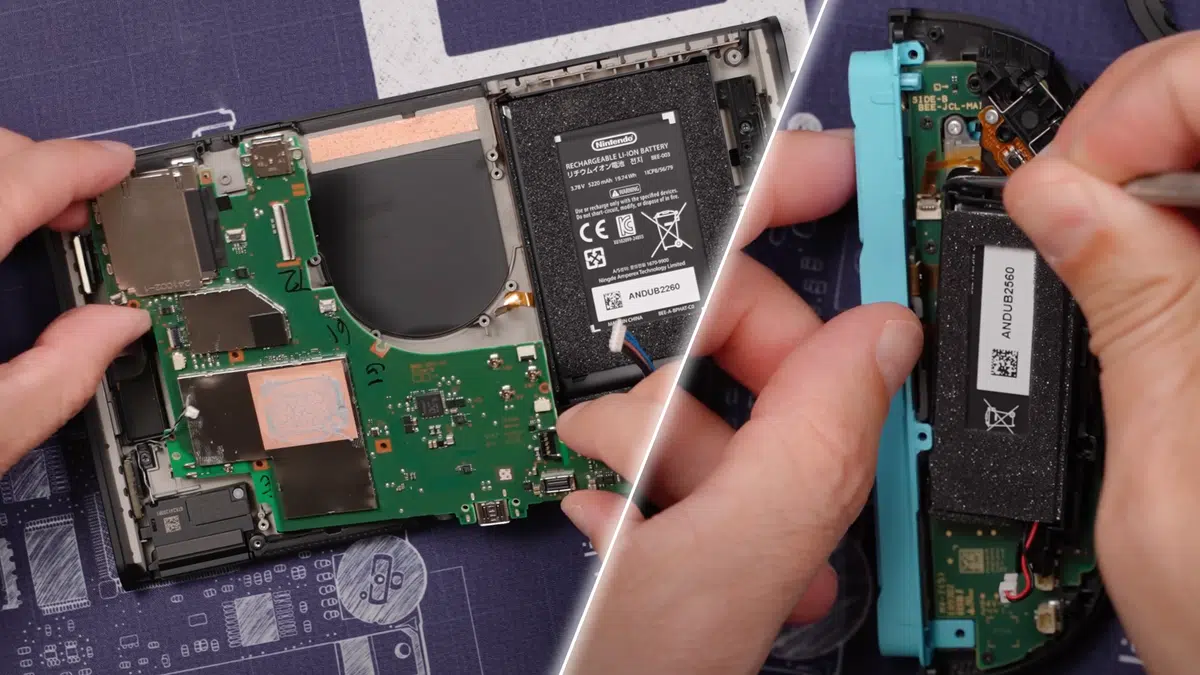Show table of content Hide table of content
Barely released, the Nintendo Switch 2 is already in the hands of the most curious technicians. And as you’d expect, some videographers haven’t waited long before taking it apart piece by piece. Among them, the YouTube channel TronicsFix, which is used to meticulous dismantling, posted its first videos on the inside of the console and the new-generation Joy-Cons on 5 and 6 June.
The result? A machine with a clean, well-thought-out internal design, but with a few technical choices that could hold back even the most do-it-yourself enthusiasts.
Switch 2: a better-assembled console, but not necessarily easier to repair
Firstly, during our Switch 2 launch live, we already communicated that Nintendo had clearly improved the build quality of its new console. This is confirmed in the teardown videos, which show a rather clean interior. Thermal dissipation seems to be better managed this time, thanks to a small, well-placed fan, a copper heat pipe and a heatsink that covers a good part of the SoC. Even the thermal paste has been carefully applied, which is far from always the case with this type of product!
But it’s not all good news, because from the very first seconds of disassembly, one thing is obvious: the screws are hidden under coloured stickers (blue and red/orange), located where the new Joy-Cons are to be clipped on. It’s a small detail that may seem insignificant, but it shows a clear intention: to discourage amateur disassembly. As TronicsFix points out, removing these stickers makes them irrecoverable, which means that dismantling them will inevitably leave visible traces. (Even if we know that we’ll be able to recover stickers from sites like AliExpress very soon).
Once the shell is removed, we notice that the USB-C port, used for both charging and docking, is soldered directly to the motherboard, which is bad news for those hoping for an easy repair in the event of breakage. The same applies to the screen connector, which is particularly thin and fragile, according to TronicsFix, which stresses the difficulty of carrying out an operation without damaging this panel.
Controllers: the Drift Joy-Con back on Nintendo Switch 2?
As for the controllers, dismantling the Joy-Con 2s reveals some changes to the internal layout. The components appear better organised, access to the battery is a little more direct, and the buttons are easier to replace. But our main focus is on the analogue sticks, and here we are disappointed…
As Nintendo of America’s Nate Bihldorff hinted back in April, the new-generation Joy-Cons still don’t use Hall-effect technology, which would enable precise, friction-free magnetic detection, thus eliminating the notorious drift problems. This finding was confirmed once again when we took the sticks apart to find out for ourselves. The result: no trace of magnets inside, so these are indeed traditional analogue sticks.
Clearly, even if the overall design evolves, the Joy-Con 2 could well end up suffering from the same wear-and-tear problems as their predecessors. Something to keep an eye on over the coming months, especially if you’re the kind of person who spends hours playing Mario Kart World or the upcoming Donkey Kong Bananza.
A promising console, but certainly not beyond reproach
Ultimately, with the Switch 2, Nintendo seems to have made real efforts on the finish, cooling and overall assembly.
But inside, the technical choices betray a certain caution, or even a form of continuity, since the soldered USB-C port, the fragile connectors and the analogue sticks, which are still susceptible to drift, remind us that this new console, however attractive it may be, is not necessarily built to last without problems. What’s more, some repairs may well prove more complicated than they appear.


